To demonstrate how velocity changes perceived pictures, we have chosen a simple arrangement of objects so that we can easily understand where we are, where the perceived objects are and which parts of them we see.
We have placed blocks with colored sides in a plane on a circle, like a dial of a watch (in the z-plane around (x, y, z) = (0, 0, 0) with radius 200). The block at 6 h has been removed to allow an unimpaired view. We name this arrangement Stonehenge like its Stone Age prototype.
The sides of the blocks are green, the front is red, the rear yellow and the upper and lower faces are reddish brown. The checkered pattern on the floor and the blocks provides coarse coordinates.
At high velocity we see the circular contours of balls again as contours of balls, not as pancakes which are flattened by relativistic length contraction. The different times of flight from the points of the contour to our eye compensate the length contraction such that the contour of a ball is perceived as a circle at all velocities.
To show this property, we have decorated the block at 9 h with a ball with a yellow front and a red back side. It looks as a ball also during our flight.
Our line of sight is marked with a small white cross. Whether at rest or in motion our field of vision consists of light rays which for us enter with an angle of up to 45° to our line of vision.
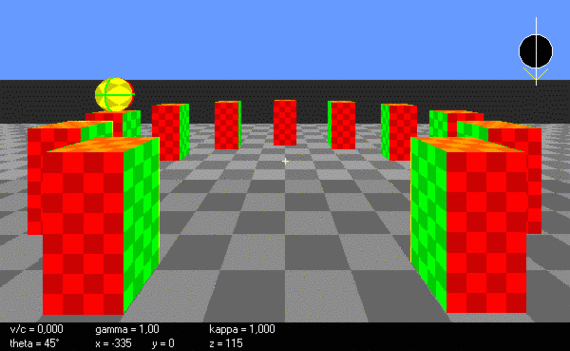


At the bottom of the pictures the ratio of our velocity \(v\) to the velocity of light, \(c\), is specified together with \( \gamma = 1 / \sqrt{1 - (v/c)^2}\) and \( \kappa = \sqrt{ ( c-v)/(c+v) }\). The angle theta is the angle between the direction to objects at the border of the picture and the line of sight. Moreover, the coordinates of our eye are given.
At the top right a small circle is inserted into the pictures which symbolizes Stonehenge from above and indicates our path of flight, our position and the direction to the objects, which we perceive at the rim of our field of vision.
If one rests at the outskirts (x= - 200) of Stonehenge and looks at the block at 12 h, one sees the following picture.
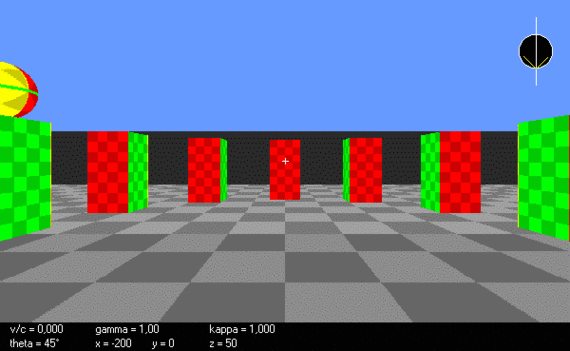
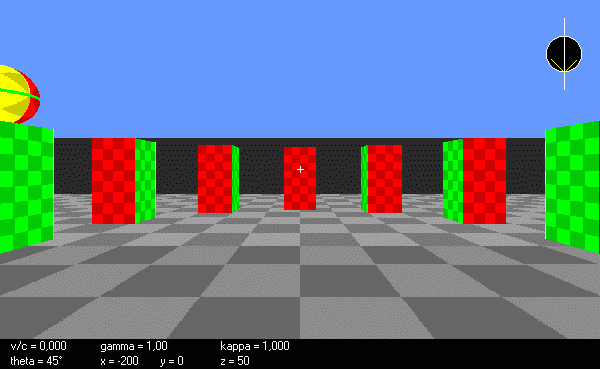

If we move with velocity \( v = 0,97c \) into the direction of sight and look from the same position we see Stonehenge shrunken, because all light rays come more from the front. Our field of vision consists of light rays which, if we rested, would enter with an angle of up to 146°
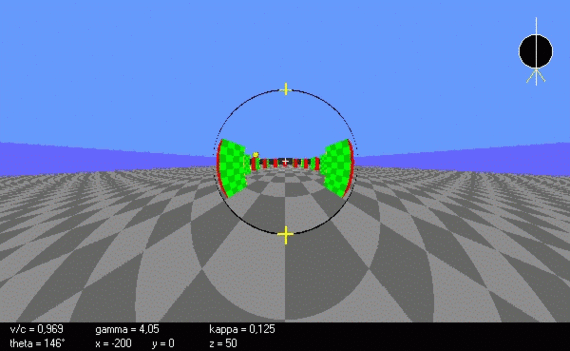
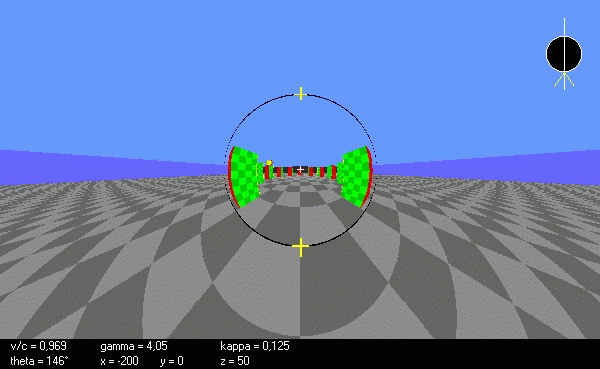

At our velocity aberration is no tiny effect. Light rays from objects in our back are tilted so much forwards into our direction of motion that we can see them in our front. Like a frog we can see what happens behind us without turning our heads. The area in which we see objects in front of us has shrunken so much that in our field of vision we also see objects which we have passed already.
In between our front and back are the points on our right or left, top or bottom and the coordinate line which passes under our feet. For someone at rest the light rays from these points enter at right angle to his line of vision. Taken together, one perceives these light rays as a circle which is in between the light rays from objects in his front and the light rays from objects in his back.
We call it Janus circle after the Roman god of doorways and passages, for the same reason for which the month between the old and the new year carries it's name January. When we move, we see the Janus circle shrunken to a smaller circle. It is inserted into the scenes which we see. Top and bottom, zenith and nadir, are marked on our Janus circle by small yellow crosses. What we see inside our Janus circle is in our front, what we see outside our Janus circle is in our back.
But, where are we ourselves? This is not evident. Though we are between back and front we do not see ourselves because we are always outside of our field of vision. So, where are we? The strange and not at all obvious answer to the question where we are is given by the Janus circle:
We are between left and right and between top and bottom in the middle of an imagined transparent membrane stretched over the Janus circle.
This will be verified when we pass the front and back side of the block at 12 h.


